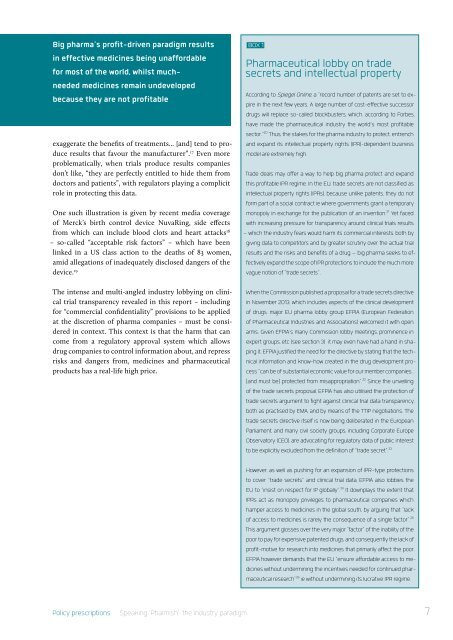Policy prescriptions
20150827_bigpharma_web
20150827_bigpharma_web
- No tags were found...
Create successful ePaper yourself
Turn your PDF publications into a flip-book with our unique Google optimized e-Paper software.
Big pharma’s profit-driven paradigm results<br />
in effective medicines being unaffordable<br />
for most of the world, whilst muchneeded<br />
medicines remain undeveloped<br />
because they are not profitable<br />
exaggerate the benefits of treatments... [and] tend to produce<br />
results that favour the manufacturer”. 17 Even more<br />
problematically, when trials produce results companies<br />
don’t like, “they are perfectly entitled to hide them from<br />
doctors and patients”, with regulators playing a complicit<br />
role in protecting this data.<br />
One such illustration is given by recent media coverage<br />
of Merck’s birth control device NuvaRing, side effects<br />
from which can include blood clots and heart attacks 18<br />
– so- called “acceptable risk factors” – which have been<br />
linked in a US class action to the deaths of 83 women,<br />
amid allegations of inadequately disclosed dangers of the<br />
device. 19<br />
The intense and multi-angled industry lobbying on clinical<br />
trial transparency revealed in this report – including<br />
for “commercial confidentiality” provisions to be applied<br />
at the discretion of pharma companies – must be considered<br />
in context. This context is that the harm that can<br />
come from a regulatory approval system which allows<br />
drug companies to control information about, and repress<br />
risks and dangers from, medicines and pharmaceutical<br />
products has a real-life high price.<br />
BOX 1<br />
Pharmaceutical lobby on trade<br />
secrets and intellectual property<br />
According to Spiegel Online, a “record number of patents are set to expire<br />
in the next few years. A large number of cost-effective successor<br />
drugs will replace so-called blockbusters, which, according to Forbes,<br />
have made the pharmaceutical industry the world’s most profitable<br />
sector.” 20 Thus, the stakes for the pharma industry to protect, entrench<br />
and expand its intellectual property rights (IPR)-dependent business<br />
model are extremely high.<br />
Trade deals may offer a way to help big pharma protect and expand<br />
this profitable IPR regime. In the EU, trade secrets are not classified as<br />
intellectual property rights (IPRs), because unlike patents, they do not<br />
form part of a social contract ie where governments grant a temporary<br />
monopoly in exchange for the publication of an invention. 21 Yet faced<br />
with increasing pressure for transparency around clinical trials results<br />
– which the industry fears would harm its commercial interests, both by<br />
giving data to competitors and by greater scrutiny over the actual trial<br />
results and the risks and benefits of a drug – big pharma seeks to effectively<br />
expand the scope of IPR protections to include the much more<br />
vague notion of “trade secrets”.<br />
When the Commission published a proposal for a trade secrets directive<br />
in November 2013, which includes aspects of the clinical development<br />
of drugs, major EU pharma lobby group EFPIA (European Federation<br />
of Pharmaceutical Industries and Associations) welcomed it with open<br />
arms. Given EFPIA’s many Commission lobby meetings, prominence in<br />
expert groups, etc (see section 3) it may even have had a hand in shaping<br />
it. EFPIA justified the need for the directive by stating that the technical<br />
information and know-how created in the drug development process<br />
“can be of substantial economic value for our member companies...<br />
[and must be] protected from misappropriation”. 22 Since the unveiling<br />
of the trade secrets proposal, EFPIA has also utilised the protection of<br />
trade secrets argument to fight against clinical trial data transparency,<br />
both as practised by EMA, and by means of the TTIP negotiations. The<br />
trade secrets directive itself is now being deliberated in the European<br />
Parliament, and many civil society groups, including Corporate Europe<br />
Observatory (CEO), are advocating for regulatory data of public interest<br />
to be explicitly excluded from the definition of “trade secret”. 23<br />
However, as well as pushing for an expansion of IPR-type protections<br />
to cover “trade secrets” and clinical trial data, EFPIA also lobbies the<br />
EU to “insist on respect for IP globally”. 24 It downplays the extent that<br />
IPRs act as monopoly privileges to pharmaceutical companies which<br />
hamper access to medicines in the global south, by arguing that “lack<br />
of access to medicines is rarely the consequence of a single factor”. 25<br />
This argument glosses over the very major “factor” of the inability of the<br />
poor to pay for expensive patented drugs, and consequently the lack of<br />
profit-motive for research into medicines that primarily affect the poor.<br />
EFPIA however demands that the EU “ensure affordable access to medicines<br />
without undermining the incentives needed for continued pharmaceutical<br />
research” 26 ie without undermining its lucrative IPR regime.<br />
<strong>Policy</strong> <strong>prescriptions</strong> Speaking ‘Pharmish’: the industry paradigm 7


